Prologue
 Back on December 12, 2014, I posted my first ever camera review on this site, for the Argus C3 Match-Matic. The idea to write about an old camera was just something I thought up on a whim and put together that review with my thoughts, and some sample pics I got from that camera. Never in a million years, would I have imagined that nearly five years later, my site would have grown into what it was.Over the years, I’ve refreshed a few posts to bring them up to my current formatting standards, but with this review, I’m leaving that original post as it was when I first published it, and creating an all new article covering the entire Argus C-series. I hope you enjoy it.
Back on December 12, 2014, I posted my first ever camera review on this site, for the Argus C3 Match-Matic. The idea to write about an old camera was just something I thought up on a whim and put together that review with my thoughts, and some sample pics I got from that camera. Never in a million years, would I have imagined that nearly five years later, my site would have grown into what it was.Over the years, I’ve refreshed a few posts to bring them up to my current formatting standards, but with this review, I’m leaving that original post as it was when I first published it, and creating an all new article covering the entire Argus C-series. I hope you enjoy it.
As I began writing this article, I began to hit milestones I had never hit with any previous camera review. My typical review is between four to six thousand words with the largest topping out at eight thousand words. But this time, I shattered the ten thousand word barrier, and hit eleven, then twelve thousands. I couldn’t stop myself, I just kept typing.
After having some sense talked into me by fellow collectors and bloggers, I decided to split up this Argus piece into five separate articles for you to enjoy in smaller parts. This week, I will release one piece at a time, with a full version of the whole article on Friday. The five parts will be:
- I – History of Argus and the C-series
- II – Repairing your Argus
- III – Identifying the Argus C-series
- IV – Using the C3 and Accessory Lenses
- V – My Results
I hope you enjoy reading everything just as much as I had writing it.
Introduction
This is the Argus C-series. First released in 1938 as the Argus Model C, the C-series includes the best selling American camera ever made, the Argus C3. Over 2.2 million were produced over the course of 28 years, the C-series saw many subtle variations and incremental improvements, but generally retained the same brick-like shape and pre-war feature set until the very last cameras came off the assembly line in 1966. The reason for it’s success was it’s unique looks, quality optics, capable feature set, and affordable price. The C-series had an interchangeable lens mount, and had a variety of German made auxiliary lenses available for it. It was used by amateurs, professionals, students, the military, and countless other people in nearly every profession.
Identifying the Argus C-Series
Argus produced the C-series from 1938 through 1966, but there were many changes along the way. Some received updates to the model number, others were just minor cosmetic changes that largely went unnoticed. I do not have in my collection every single variant of the C-series, but I have most of them so what follows is my attempt at a comprehensive identification guide.
Note: A large amount of the information below comes from the Argus Camera Information Reference Site by Phillip G. Sterritt. This is a wonderful resource that I strongly recommend you take some time to read if you’d like more information than what I have presented below. The range of serial numbers he lists for each year comes from a variety of sources, but most significantly a survey he did of readers submitting information about their cameras and should only be considered an estimate.
C (1938)
The original Argus C was produced only in 1938. It was the most basic camera and sold for $25 upon it’s release. The most distinct feature of the C is the lack of the coupling gear between the lens and rangefinder window. This means that the rangefinder and lens could be turned independently of each other. In order to take a reading, you’d need to look through the rangefinder window and get your images to line up, then look at the rangefinder wheel and see what distance is indicated, and then turn the lens to match the same distance and take your photo.
As you might imagine, this was rather cumbersome and was quickly resolved with the release of the C2 which added a coupling gear that appeared on all later models.
Fun Fact: Because the lens on the original C had to be focused separately from the rangefinder, it is the only Argus 50mm lens with it’s own focusing scale. All later Cintars only indicated distance using the rangefinder wheel.
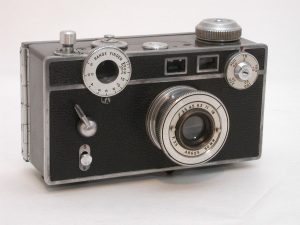
There are two variations of the original C, the earlier ones with a “Fast” and “Slow” speed switch which alternated the available shutter speeds between two ranges of speeds. The shutter speed dial would have two numbers at each position, the slower for when the switch is in the Slow position and the other for the Fast position. Phillip Sterritt has some information including two drawings by collector Bill Powell that shows how the original C shutter worked and how it compares to the later design.
The earlier design must have been either problematic or too expensive to produce as Argus quickly replaced it with a simpler system in which the shutter speed dial has ten speeds from 5 to 300 on it. It is estimated that less than 1800 cameras were produced with this switch, with the rest having the single 10 speed shutter dial.
C2 (1938 – 1942)
Manual: http://www.cameramanuals.org/argus/argus_c-2.pdf
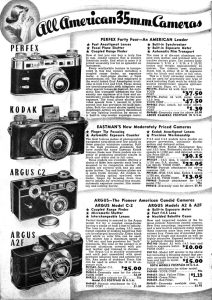
Shortly after the Argus C’s release, an updated model called the C2 debuted which added a coupling gear in between the lens mount and rangefinder wheel. This allowed for simultaneous adjustment of the focus distance while seeing distance changes in the rangefinder. By 1938, coupled rangefinders had become the norm in more expensive German cameras like the Leica II and Kodak Retina II, so to have this feature in an inexpensive American camera was a big deal.
Even more amazing is that the price of the C2 remained at $25 meaning the upgrade was essentially free. I found no information about this, but I wonder if Argus offered an upgrade or trade-in program to people who had already bought the original model, and wanted the coupled model since they sold for the same price.
The ad to the right comes from the Lafayette Camera Corporation’s 1939 catalog and shows the Argus C2 selling for $25, which was lower than the non-rangefinder Kodak 35, and the top of the line American rangefinder, the Perfex Forty-Four.
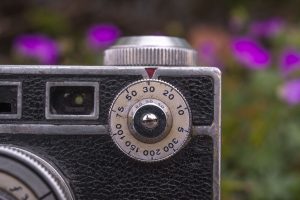
The C2 saw a few minor cosmetic changes during it’s five year production run such as:
- Shutter release button changed shape in late 1939
- Lenses began being branded as Argus Cintar in 1940
- Lens aperture scale changed from 3.5, 4.5, 6.3, 11, 18 to 3.5, 4.5, 6.3, 9, 12.7, 18 in 1940
- Addition of Weston film reminder dial on the back in 1940
- Ten shutter speeds reduced to seven in 1941
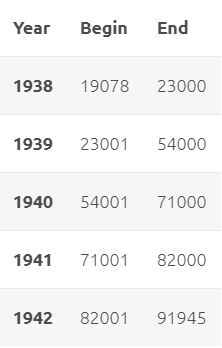 You can tell which year your C2 was made by looking at the serial number in the film compartment which will either be stamped in paint behind the take up spool, or pressed into the Bakelite beneath the film gate. For the cameras with the number stamped into the Bakelite, there is a prefix of ’02’ that can be ignored. According to
You can tell which year your C2 was made by looking at the serial number in the film compartment which will either be stamped in paint behind the take up spool, or pressed into the Bakelite beneath the film gate. For the cameras with the number stamped into the Bakelite, there is a prefix of ’02’ that can be ignored. According to
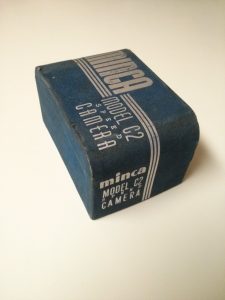
Fun Fact: Around 1939 or perhaps 1940, a small number of Argus C2 and C3 cameras were exported for sale in Great Britain under the name “Minca Speed Camera”. Not only were the cameras packaged under the Minca name, but the 50mm lens is identified as a Minca Cintar.
The image to the right shows a Minca C2’s original packaging.
C3 Prewar (1939 – 1942)
With the release of the C2, Argus wasn’t done improving upon the original model as in early 1939, they released a third model called the C3 which added flash synchronization to the coupled rangefinder of the C2. In addition to internal changes to the shutter, the camera would receive two holes on the camera’s right side that allowed a proprietary Argus flash gun to be connected.
The new C3 carried a $5 premium over the C2 and originally sold for $30 in 1939 but had risen to $45.05 by February 1942 due to rapid inflation as a result of the ongoing war in Europe. Each of these prices compare to $550 and $700 respectively, today.
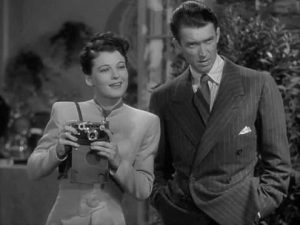
When Gustave Fassin designed the Argus C, he likely had no idea how successful it would be or that it would be produced for another 28 years. He also likely did not intend for it to be a war time camera, but it’s rugged and reliable design proved to be a popular choice for soldiers wanting to photograph the war.

Perhaps the most well known use of someone using an Argus during war time, was Pfc. Tony Vaccaro who in 1941 purchased an Argus C3 for the price of $47 and upon being drafted into the US Army in 1943, took it with him to fight in the war. Vaccaro was a private in the 83rd Infantry Division of the U.S. Army and fought in Normandy, Belgium, Luxembourg, and Germany. Often used as a scout, this gave Vaccaro many opportunities to get out and take photos. He was not an official Army photographer however, so he was responsible for acquiring, carrying, and developing his own film.
He would borrow helmets from other soldiers to use as tanks developing his film and would hang the negatives from tree branches to dry. After developing, he would carry his negatives with him until he could get them somewhere safe. It is estimated that Vaccaro shot over 8000 images on his Argus C3, many of which have become iconic war time photos. If you’ve ever seen a battlefield image from World War II, there is a good chance it was shot on a Prewar Argus C3 either by Vaccaro or someone else.
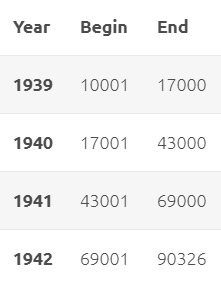 In 2016, HBO Documentary Films created “Underfire: The Untold Story of Pfc. Tony Vacarro” in which he talks about his time shooting his C3 during the war. Last August, EMULSIVE interviewed Tony Vaccaro in an article called “I am Tony Vaccaro and This is Why I Shoot Film”, in which Vaccaro talks more about his experiences in the war, and why he continues to shoot film.
In 2016, HBO Documentary Films created “Underfire: The Untold Story of Pfc. Tony Vacarro” in which he talks about his time shooting his C3 during the war. Last August, EMULSIVE interviewed Tony Vaccaro in an article called “I am Tony Vaccaro and This is Why I Shoot Film”, in which Vaccaro talks more about his experiences in the war, and why he continues to shoot film.
The C2 and C3 were produced concurrently and saw many of the same cosmetic variations such as the switch from ten to seven shutter speeds and the addition of a Weston film reminder dial. Other than serial number, the most obvious way to tell the difference between the two is the presence of the two flash sync ports on the camera’s side.
Like the C2, the exact year of manufacture can be determined by the serial number which can be found either behind the take up spool, or stamped into the Bakelite beneath the film gate in the film compartment. Serial numbers behind the take up spool have a prefix of ‘C3′ and serial numbers in the Bakelite have a prefix of ’03’ that can be ignored.
C3 Postwar (1945 – 1953)
During the United States’s involvement in World War II, Argus stopped producing cameras and concentrated on manufacturing goods for the American war effort such as radios, power supplies, and other optical products. When production resumed in late 1945, the Argus C3 returned mostly unchanged.
The first cameras produced until mid 1946 had the same uncoated Argus Cintar lenses, non standard aperture scale, chrome cocking lever, and blue tinted rangefinder as the prewar cameras did. I have no evidence of this, but it’s plausible that these cameras were built from left over parts from the earlier cameras. Whatever the case, by July 1946, C3s with coated lenses, a standard f/stop scale, black painted cocking lever, and yellow tinted rangefinder began to appear.
The years following World War II were some of the most successful for the Argus C3 as people remembered it’s popular reputation from before the war, but with a shortage of cameras from Germany, that left American companies like Argus as the sole providers of new cameras for returning soldiers.
Inflation caused the price of the postwar cameras to rise by 1949 to $78.08 including a case and flash, which when adjusted for inflation is comparable to $850 today which seems high, but if you consider in 1949, a Leica IIIC with f/3.5 Elmar sold new for $280, it was still quite the bargain.
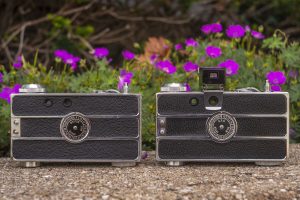
The price of the C3 continued to fluctuate in the early 1950s, dropping to $59.99 in early 1950, and then back up to $66.50 in 1951, and finally $69.50 in 1953. Despite the varying prices, when adjusted for inflation, all three of these prices are comparable to around $650 today.
The C3 remained largely unchanged over the next several years with only a couple minor variances:
- The Weston film reminder dial on the back of the camera was replaced with one with ASA speeds in 1948
- A rectangular “Argus” badge appeared in the bottom left front corner of the camera in 1950
In 1954, a slightly revised C3 made it’s debut unofficially referred to as the C3 Colormatic. The use of the word “Colormatic” was used in Argus literature to refer to color coded numbers on the shutter speed dial, lens, and focusing scale that was there to help novice photographers get accurate snapshots in average lighting. The red markings were designed for Kodak Ektachrome or Anscochrome color film, or Plus X or Supreme black and white film. The yellow markings were for Kodachrome film. The shutter speed for 1/25 was also coded in green which was to be used with flashbulbs, indicating the correct flash sync speed.
An often overlooked feature of the C3 Colormatic was that for the first time, the camera supported electronic flash synchronization at all speeds when using an electronic flash. You still had to use an Argus flashgun, but you could get X-sync at speeds as fast as 1/300, which the earlier cameras could not do.
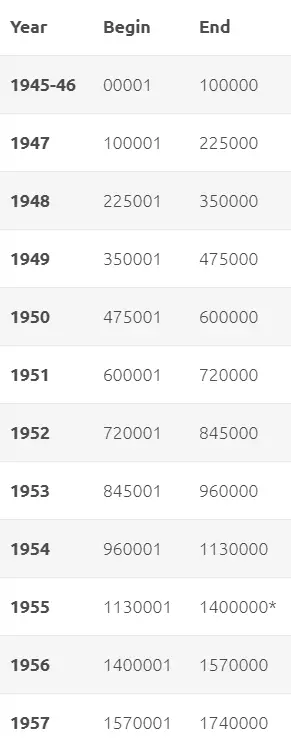
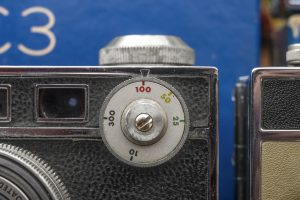
The C3 Colormatic also removed the circular ASA film reminder dial on the back door of the camera, instead having three separate strips of body covering separated by chrome trim. In 1957 only, the chrome trim was removed and the back door of the camera had a large single piece of body covering.
Although the C3 was nearly 20 years old, it was still a popular camera and between the years of 1954 and 1957 an average of about 150,000 were sold making these very common on the used market today.
Both the Postwar and Colormatic cameras can easily be dated using the serial number stamped into the Bakelite on the inside of the film compartment. Unlike the Prewar cameras, there is no prefix to the serial numbers. The chart to the right shows a wide range of serial numbers including both the original Postwar and Colormatic C3s.
Standard C3 and Match-Matic C3 (1958 – 1966)
The 1950s saw a great number of changes in the camera industry. The rise of quality Japanese cameras, a preference for SLR cameras over rangefinders, and the introduction of “electric eye” auto exposure cameras, so as the decade was coming to a close for there to still be a pre-war camera available for purchase must have seemed a bit odd to many potential customers.
Throughout the 1950s, Argus released several other models, many of which were much more advanced than the C3 and improved on most of it’s features, but the extreme reliability and performance of the C3 kept it a popular choice. While there were a great many minor changes to the camera, not much had changed since it’s introduction in 1938, and as a result, in 1958 Argus gave the camera it’s first real refresh.

Argus had already used the name C4 for a completely different camera, so for these new models, they were called the Standard C3 and Match-Matic C3. Upon it’s release in 1958, the Match-Matic had a list price of $74.95 whcih when adjusted for inflation, compares to $650 today which is consistent with inflation adjusted prices from the early 1950s. I was unable to find any pricing or advertising materials for the Standard C3, but I have to imagine it was the same.
Both the Standard and Match-Matic gained a new flat top shutter release button, an accessory shoe, and an accessory selenium cell exposure meter that was sold with every camera. The meter was mostly the same between the Standard and Match-Matic with the only difference between the LS-3 meter included with the Standard uses aperture f/stops and the LC-3 meter used the Match-Matic’s numbering system.
The accessory shoe also allowed for standard auxiliary viewfinders to be used for the wide angle and telephoto Argus lenses that were available. Prior to these models, the only auxiliary viewfinders were clip on types made specifically for the C3 that attached to the front and rear viewfinder windows.
The standard Cintar 50mm lens got a redesign too with a brushed aluminum exterior ring and a built in Series V retaining ring to allow for drop-in filters and other lens accessories.
Perhaps the biggest change for the Match-Matic was a new simplified exposure system that completely did away with standard shutter speeds and aperture f/stops.
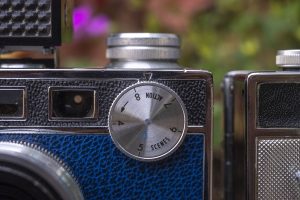
Instead, the shutter speed selector and lens had a numbering scale that when added together was supposed to match up with a corresponding numbering scale on the attached meter. This was thought to be easier for novice photographers as they didn’t need to know anything about shutter speeds or f/stops. If the exposure meter was pointing to the number 12 on the meter, any combination of shutter speeds or lens apertures that added up to 12 would give proper exposure. The idea of a Match-Matic type system was not unique to Argus as other companies such as Minolta had them on their Autocords and other cameras.
The Standard C3 also came with the redesigned lens with Series V filter capability, an accessory shoe, and an included light meter, but continued to use normal f/stops and shutter speeds.

One final change for the Match-Matic was a very distinct two tone beige/tan and black body covering on the camera. The Standard C3 retained the original’s all black design. This, combined with the retro 1930s brick like shape makes the Match-Matic C3 one of the most distinct looking cameras of all time.
 With the Standard and Match-Matic cameras, came a new serial numbering system. Instead of being stamped inside of the film compartment, serial numbers were now on the bottom of the camera and were eight digits long, with the fourth digit being a date code indicating which year the camera was made.
With the Standard and Match-Matic cameras, came a new serial numbering system. Instead of being stamped inside of the film compartment, serial numbers were now on the bottom of the camera and were eight digits long, with the fourth digit being a date code indicating which year the camera was made.
There are inconsistencies with cameras made in 1958 that did not follow the usual pattern, which Phillip Sterritt covers in his Argus Dating Guide but otherwise every other year follows the pattern shown in the chart to the left.
Golden Shield by Argus (1960 – 1961)
In 1959, Argus Inc. was acquired by Sylvania Electric Products Inc., who themselves had merged with General Telephone to form General Telephone and Electronics (GTE) and one of the other companies owned by Sylvania was the Golden Shield Corporation of Great Neck, New York.
The “Golden Shield” brand was exclusively sold through jewelry stores across the country in an effort to get more household products into the hands of buyers by “blinging” them up with gold trim and a fancy name plate. The price of the camera was sometimes listed as $64.95, but was more commonly offered as part of an installment plan with monthly payments.

Golden Shield was not limited to just cameras, as there existed a huge range of products like radios, typewriters, blenders, and vacuum cleaners. The ad to the right comes from the December 10, 1961 issue of the Decatur Herald and shows an ad for Carson Jewelers and their whole line up of Golden Shield products.
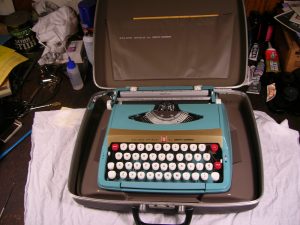
The image to the left is of a “Golden Shield by Smith-Corona” typewriter. Radio collector Joe Haupt, has a Flickr album of various Golden Shield radios in his collection if you’d like to see more.
The Golden Shield by Argus camera is identical in function to the regular Match-Matic, even using the same Match-Matic exposure numbering system and light meter. Golden Shield serial numbers even fall within the range of Match-Matic cameras suggesting these started off as normal Match-Matics and reskinned at a later time. The only difference was a textured metal foil body covering and a rectangular black, red, and gold name plate on the front of the camera where the normal Argus logo would appear.
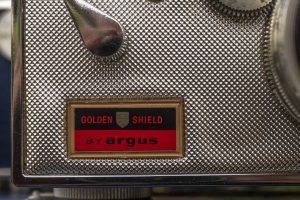
I found several references to Golden Shield cameras and other products in newspapers all over the United States in the early 1960s, suggesting this was a nationwide roll out. One site even suggests that there was a Golden Shield catalog for the 1960 and 1961 Christmas seasons, but I was unable to find an example of one.
Argus never maintained official production numbers for it’s cameras, but it is estimated that about 2000 of them were ever made, making them one of the rarest of the entire Argus C-series.
Since the Golden Shield is not any different than a regular Match-Matic, there’s not much else to say about them, so here is a gallery of some more pictures I took of mine.
Please come back tomorrow for Part IV – Using the C3 and Accessory Lenses.

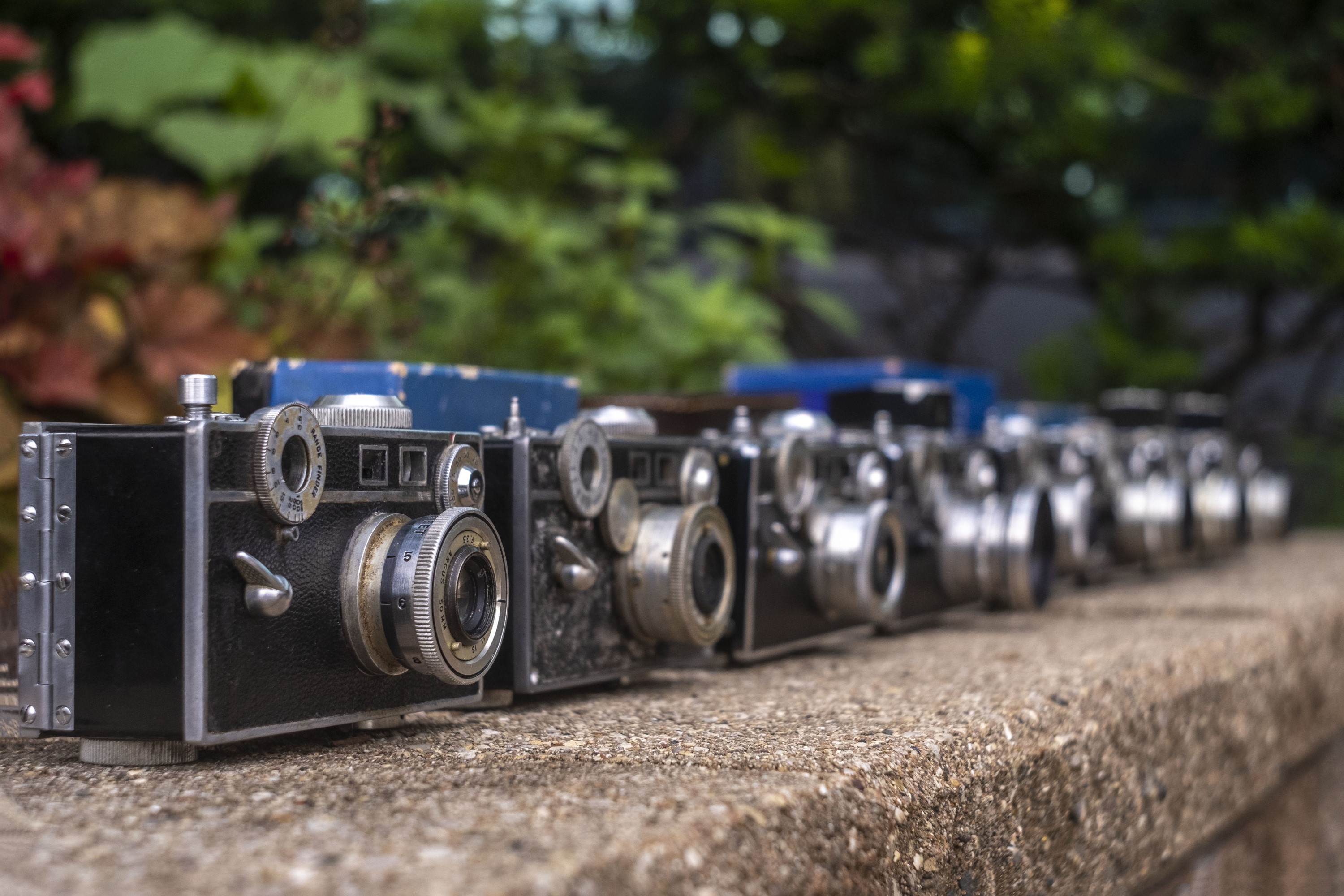
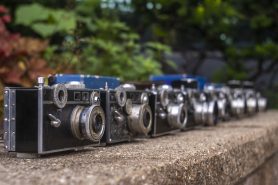
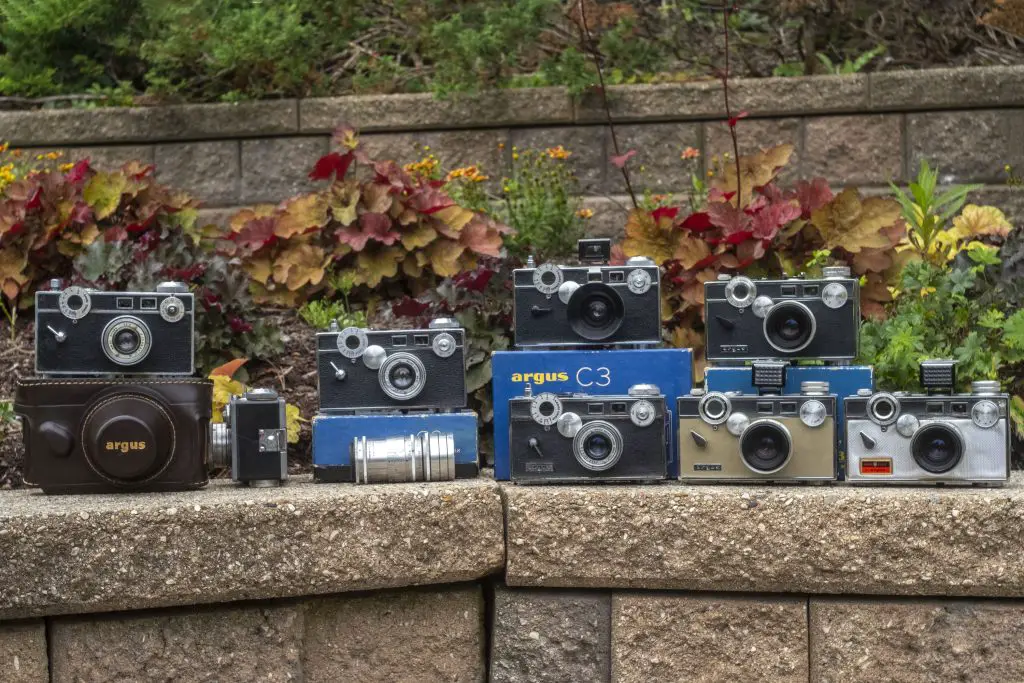
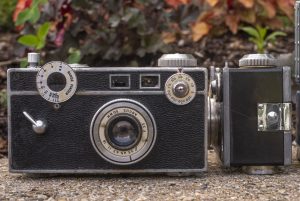
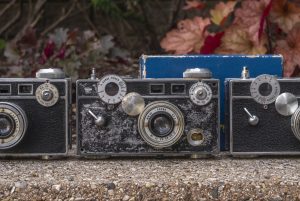
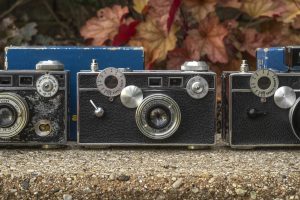






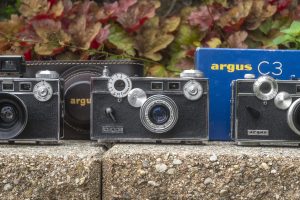

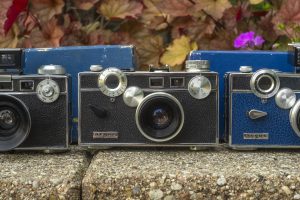
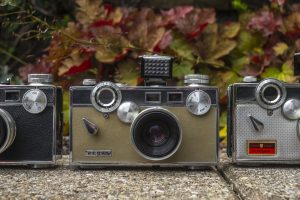

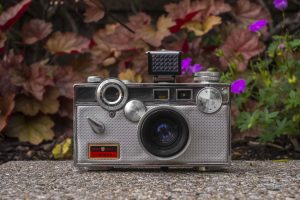






Shoot! I sold my C3 Golden Shield a few months ago for 150 dollars! Was this a wise choice?
I’d say you got a fair value at $150, but in terms of whether it was wise choice depends on how important of a camera it was to keep in your collection. I really like my Golden Shield and it’s unlikely I’d ever sell it for anywhere near it’s actual value. Now if someone wanted to pay me way more than it’s worth, that’s a different story!
Mike I would say so! considering I gave him that Golden Shield for FREE!
And very much appreciated! 🙂
Outstanding article, wonderful work!
Mike,
Another fun fact Argus cameras have appeared in popilar media (movies, the theater, television, music videos, etc) in every devade since the introduction of the Argus A. I have colloected stills from every instance I have ben able to find. If anyone reading this knows of an appearance of an Argus camera in populs media please report thirogh the AGC web site.
Great review. I turn C3s into beautiful lamps and I’ve made hundreds over the past few years…it’s my top selling piece. The other day I found a C3 with black leather but with what looks like dark green enamel on all the chrome trim. It looks like factory finish rather than a DIY job. Have you ever seen one of these? It’s obviously rare…think it’s valuable?
Argus never made a camera with a green enamel body. Anything you find like that today was painted by some previous owner. Where do you sell your C3 lamps at?
Looks like I might have a slight variation of the Match-Matic.
It has a Phillips screw through the front of gear between the adjust dial and the lens housing.
https://i.ibb.co/PNGW7dV/IMG-5637-copy.jpg
Very nice image! That screw is almost certainly an aftermarket replacement. There should be a large flat disc there, and either a previous owner lost the original and used that as a replacement, or perhaps he or she thought the screw would be more secure than the original part. It was not unusual for owners of these cameras to customize them like this. Either way, its a nice camera and I hope you get a chance to shoot some film in it!